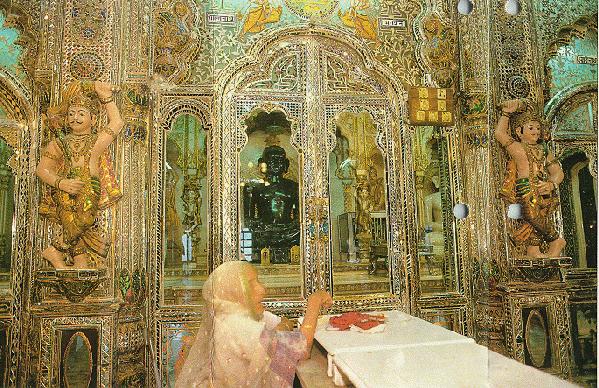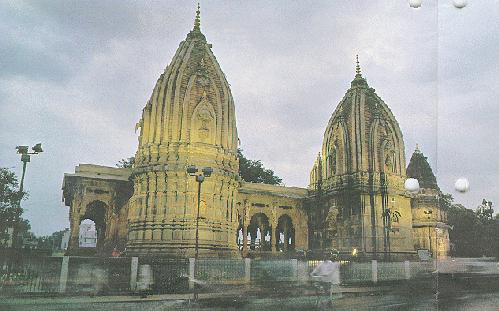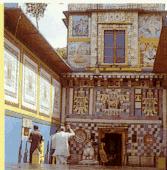
Indore
Planned and built by Rani
Ahilyabai, the brave Holkar queen, Indore lies to the extreme west of Madhya
Pradesh on the banks of the rivers Saraswati and Khan which unite at the centre
of the city. The bustling and vibrant city, 186 km from Bhopal, derives its name
from the 18th century Indreshwar temple
The history of Indore is inseparable from the history of the Holkar State. The
founder of the House of Holkars was Malhar Rao Holkar, born in 1693 AD. His
soldierly qualities brought him to the forefront under the Peshwa and he was
rewarded with the gift of territories comprising the Indore region. Malhar Rao
was succeeded by his grandson, on whose death, without issue, his mother,
Maharani Devi Ahilya Bai ascended the throne
Top
Places to See
Lal Baag

Lal Baag Palace is one of the grandest monuments the Holkar dynasty left Indore.
A reflection of their taste, grandeur and lifestyle, its construction began in
1886 under Tukoji Rao Holkar II, and was carried out in three phases. The final
phase was completed in 1921 under Tukoji Rao Holkar III. Many royal receptions
were held here. It has a total area of 28 hectares, and at one time it had the
reputation of having one of the best rose gardens in the country.
Bada Ganpati

Better known for its size than antiquity, this temple houses perhaps the largest
Ganesh idol in the world measuring 25 feet from crown to foot. Created as a
result of the dream of an Avantika (Ujjain) resident, Shri Dadhich, it was built
in 1875.
Kanch Mandir

This Jain temple is an architectural marvel in glass. The walls, ceilings,
floors, pillars and door knobs are entirely inlaid with glass. Even paintings
are done in glass. Atop is a special glass chamber which multiplies the three
statues of Lord Mahavira installed there into an indefinite number (said to be
visible upto 21 times, corresponding to the 21 tirthankaras).
Top
Town Hall
Made in 1904 and originally named King Edwards Hall, it was renamed Mahatma
Gandhi Hall in 1948. Its architectural style is Indo-Gothic. Made in Seoni
stone, its domes and staples are a landmark of Indore today. It has a four-faced
clock tower in front, because of which it is locally known as Ghanta Ghar.
It is frequently the venue for the various book and painting exhibitions, fairs
and festivals held throughout the year. The building also has a library, a
children's park and a temple.
Central Museum
The Indore Museum houses the finest collection of Parmar sculptures from
Hinglajgarh. The Parmar style originated here, and is characterized by
proportioned figures, carefully and ornately depicted in stone. The museum is
also known for its collection of coins, arms and armour.
Gita Bhavan
Adorned with many statues of gods of various religions, its construction is
inspired by the religious motto "many names to a God is after all of one
God."
Chattris
 Chhatris are the tombs or cenotaphs erected in memory of dead Holkar rulers
and their family members. The Chhatris picturesquely poised on the Khan river
banks near Rajawada are incomparable in terms of Maratha architecture and
sculpture of their period. At Chhatri Baag is the main collection of tombs
housed in two compounds. Close by is the beautiful Bolia Sarkar's Chhatri
constructed in 1858 AD in memory of Sardar Chimnaji Appa Sahib Bolia. Chhatris are the tombs or cenotaphs erected in memory of dead Holkar rulers
and their family members. The Chhatris picturesquely poised on the Khan river
banks near Rajawada are incomparable in terms of Maratha architecture and
sculpture of their period. At Chhatri Baag is the main collection of tombs
housed in two compounds. Close by is the beautiful Bolia Sarkar's Chhatri
constructed in 1858 AD in memory of Sardar Chimnaji Appa Sahib Bolia.
Annapurna

This temple was inspired by the Meenakshi temple of
Madurai. Four life-sized
elephants hold an ornately decorated gate in plaster. Inside the temple of
Annapurna Devi are also temples of Shiva, Kal Bhairava, Hanuman and a Pravachan
Hall. The outer wall of the main temple is decorated with colourful motifs from
mythological stories.
Top
Khajrana

The citizens of Indore have great faith in this Ganesh temple, built during the
reign of Ahilyabai Holkar. It is believed that all wishes are fulfilled by
praying here. Nearby is the dargah of Nahar Sayed. This is an important
pilgrimage place for Maita Muslims.
Kasturbagram
8 km from Indore, the Kasturba Gandhi National Memorial Trust was founded by
Mahatma Gandhi. Its headquarter were shifted from Wardha to Indore in 1915. The
main objective of this trust is showing ways of improvement in the quality of
village life and the welfare of rural women and children. Some of its many
commendable activities are : agricultural production, research, training,
experiments in fruit orchards, social forestry, new renewable sources of energy,
gobar gas, better water management, rural institute for girls, village
sanitation programmes etc.
Bijasen Tekri
A 2 minutes drive from the airport leads you to a hillock on which was perched a
guest house of the Holkars, now converted into Border Security Arms Museum, as
well as a small temple of Bijasen Mata, built in 1920, which has a magnificent
view of the sunset. A mela (fair) is held during the Navratri. A good picnic
spot, with a breathtaking view of Indore city by night.
Gomatgiri
The Jain Samaj has constructed a 21 feet statue of Lord
Gomateshwar, a replica
of the Bahubali statue of Shravanbelagola. Also built here are 24 marble temples
with shilars for each tirthankar.
.Top
|



